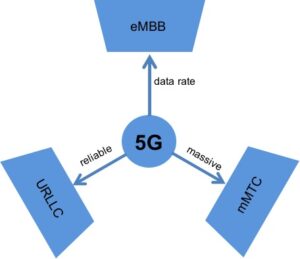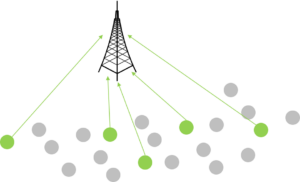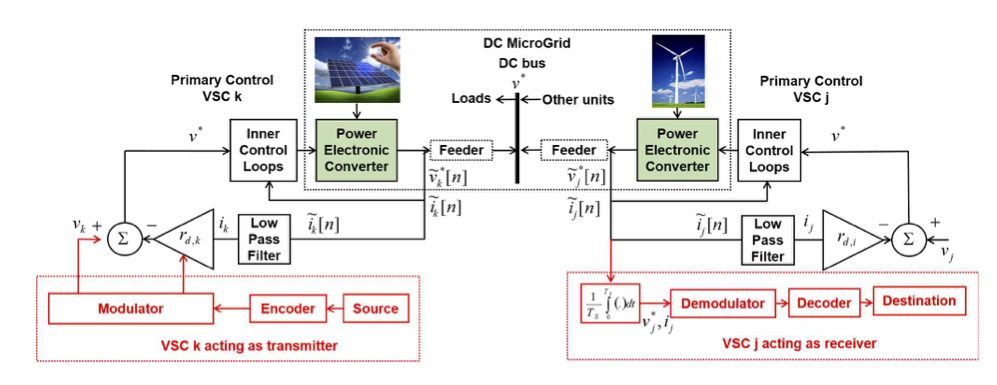This is a sample of the research topics I am working on. More details on the ongoing projects can be found at the webpage of my research group.
5G system design
During the past few years there has been a growing consensus that 5G wireless systems will support three generic services, which, according to the ITU-R nomenclature, are classified as Enhanced Mobile Broadband (eMBB), Massive Machine-Type Communications (mMTC) and Ultra-reliable and low-latencycommunications (URLLC). We remark that URLLC is also sometimes referred to as Mission Critical Communications. A succinct characterization of these services can be put forward as follows:
- eMBB supports stable connections with very high peak data rates, as well as moderate rates for cell-edge users;
- mMTC supports a massive number of Internet-of-Things (IoT) devices, which are only sporadically active and send small data payloads;
- URLLC supports the low-latency transmissions of small payloads with very high reliability levels from a limited set of terminals, which are active according to patterns typically specified by outside events, such as alarms.
Our research group was part of METIS (2012-2015), the first large project in Europe, and perhaps worldwide, dedicated to 5G. Among the other achievements, this project was among the first to recognize the three generic services described above, although under different names.
Our research interest is to investigate the building blocks needed to support each of the three services, but also to design a system that is capable to support all three services efficiently.
 Communication protocols for massive uncoordinated access
Communication protocols for massive uncoordinated access
In many Internet-of-Things scenarios there is a massive set of machine-type devices (call them M2M devices) that are connected to an access point or a Base Station (BS). In a given time period only a subset of these devices is active and wants to communicate to the BS. The root of the problem is that the BS does not know who is active and thus cannot grant access right to the devices in a way that they avoid collisions with each other; hence, the M2M devices need to contend in order to gain access. We are working on solutions based on coded random access, use of signatures and Bloom filtering, resource pooling, and others. In our laboratory we are working on a testbed that enables us to experimentally test protocols for massive access.
Ultra-reliable and low latency wireless communication
Wireless communication is becoming a commodity. In 2015, for the first time in the developing countries, the percentage of the population that possess a mobile phone has surpassed the percentage of those that have constant access to water and electricity. Yet, although ubiquitous, wireless communication links are not as reliable as the wired ones, as they work 95%-99% of the time or less. Ultra-reliable wireless communication is the one that is available practically all the time and can be trusted as much as one trusts wired communication. Read more in this introductory article.
The changes that ultra-reliable wireless communication can bring are profound, touching many aspects of work and life. Once an application developer or even a whole vertical industry can safely assume that there is a (minimal) data rate that can be guaranteed to be delivered over a wireless connection >99.99% of the time, the approach to system design and operation changes fundamentally. For example, such assumption motivates a designer of an industrial robotic system to think of a robot as a set of wirelessly interconnected modules that can be orchestrated to carry out a task rather than a single entity that contains all modules connected by wires. As another example, remote assistance to children or elderly can become a viable option once we know that we can trust the wireless connection that connects the sensors/actuators to the infrastructure and to the person that can take action if needed.
Communication with short packets
The advancement of wireless systems delivering high data rates is largely based on the classical information-theoretic/coding principles that show how one can send reliably a long data packet. However, at least two of the three generic 5G services, mMTC and URLLC are based on short packets. Current wireless systems are not designed to support short-packet transmissions. For example, the design of current systems relies on the assumption that the metadata (control information) is of negligible size compared to the actual information payload. Hence, transmitting metadata using heuristic methods does not affect the overall system performance. However, when the packets are short, metadata may be of the same size as the payload, and the conventional methods to transmit it may be highly suboptimal.
Short packets are changing the way communication protocols are built. Read this introductory article for more insight on the topic or a sample of our research on downlink frame design for short packets.
Two-way communication in ultra-dense wireless networks
Traditionally, the downlink and the uplink traffic in wireless networks have been considered separately and the methods have either focused on optimization of downlink or on uplink transmissions. We are interested in the question: what happens when one considers downlink and uplink traffic jointly? Does it lead to new opportunities and insights? This question naturally occurs in with the emerging technology for full-duplex wireless communications. Our work on CoMPflex is a generalization of the concept of a full-duplex transceiver. Besides this, there are other new aspects that emerge when downlink/uplink traffic is considered jointly, as seen in the concept of interference spins.
Smart grid communications
Communication represents a key ingredient of the smart electricity grid and we are addressing multiple aspects of smart grid communications in our research. My research in the area includes works related to smart metering and how it is supported by the cellular wireless systems. 
Another line of work is related to power talk, the concept for communication in microgrids without that does not use dedicated modems, but instead relies on the power electronic elements to modulate information over the power line.
Communication protocols for systems with massive number of antennas
Systems with massive number of antennas will be a key element of the 5G wireless systems and they come in two flavors: Massive MIMO and millmeter wave (mmWave) systems.
Massive MIMO has the capability to provide very high data rates in lower frequency bands, by greatly improving the cell spectral efficiency, measured in bit/s/Hz/cell. Massive MIMO is often described as a system with many antennas at the access points, which serve a number of devices that is much smaller than the number of antennas. We are investigating the new challenges that the massive MIMO concept poses to the design of communication protocols and, specifically, random access protocols.
Communication in the mmWave frequency band makes use of the abundant amount of spectrum available e.g. in the 60 GHz band. In order to overcome the propagation challenges, mmWave systems use a large number of antenna elements both at the base station and at the user equipment, which lead to high directivity gains, fully-directional communications, and possible noise-limited operation. This calls for new approach in system design and MAC-layer techniques.
Wireless relaying and backhauling
During the last decade we have been active in the area of wireless systems with relays. A large part of the work has been in the direction traced by two-way relaying and Physical-Layer Network Coding (PLNC). Some of our early works in the area can be found here and here, while one of the latest works puts wireless network coding in the context of backhauling.
